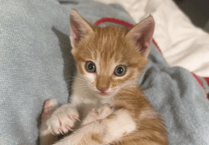The Isle of Man has fewer wild mammals than England, Ireland, Scotland and Wales.
A dearth of medium-sized meat eaters like foxes and badgers in the food chain is one of the reasons why we have so many feral cats.
Nor does the Isle of Man have any native common shrews; but it is home to pygmy shrews.
Shrews are, officially, the UK’s smallest mammal, and they play a hugely important role in the food chain.
They are a source of food for larger mammals (although domestic cats don’t seem to like the smell or taste of them and so they simply catch, rather than eat them) and they play a vital part in the diet of owls and birds of prey.
Pygmy shrews can’t stop eating. Their metabolism is so fast that two hours after a meal they are starving again.
Hibernation is out of the question because they are too small to store fat reserves, and so they have to remain active during the winter months, eating ceaselessly to keep warm.
They particularly enjoy a diet of beetles, spiders, snails and woodlice, and they need to eat up to 125% of their body weight each day in order to survive.
Their long, whiskery snouts (which make them easy to distinguish from mice) are ideal for probing in leaf litter and soil, and they compensate for the shrews’ poor eyesight.
They can emit high-pitched squeaks when defending their territory, particularly during the summer months, and they only live for about 12 months – just long enough to have one or two litters.
And shrews are in the news. Admittedly not in the Manx news, but it’s probably only a matter of time before what’s happened in the UK takes place here too.
The greater white-toothed shrew has been discovered in the north east of England, and has been declared by the British Mammal Society to be the first non-native mammal to become established in the UK since the American mink in the 1920s.
The greater white-toothed shrew is normally found in western continental Europe, on some of the Channel Islands, and in a small part of north Africa; which means that the Sunderland population is the most northerly in the world.
The newly discovered British population probably originated when shrews were accidentally transported in consignments of plants, fruits or vegetables from continental Europe.
The impact of non-native species on the ecosystem is sometimes difficult to measure (take wallabies in the Isle of Man, for example), but, sadly, it is likely that the ‘new’ shrews will have a detrimental effect on existing UK shrew populations.
Scientific research in Ireland has demonstrated that the greater white-toothed shrew has wiped out colonies of the, much smaller, pygmy shrews.
If you are a keen wildlife observer, or the owner of a cat that likes to hunt, and you think the shrew you have spotted looks different from the ones you normally see, then a rule of thumb is that the greater white-toothed shrew has a distinctive, rounder head that makes it look like a Clanger.
Although shrews don’t hibernate like hedgehogs, they may still find refuge in the bonfire that you have been building for the past few days. If possible, please move the fire just before you burn it or, at the very least, light it from one side only so that anything trapped inside can escape.
If you’re planning to have fireworks at your bonfire party, please let us know (email [email protected]) so that we can post times and dates on our social media pages to alert pet and livestock owners.
Please also consider using silent, or quiet, fireworks which are just as beautiful. The RSPCA has some excellent advice for pet owners on its website.


.jpg?width=209&height=140&crop=209:145,smart&quality=75)


Comments
This article has no comments yet. Be the first to leave a comment.